If you're planning to visit Andalucia, you can't miss one of its highlights: the white villages or 'pueblos blancos'. Here are my picks for the top 10 white villages in Andalucia - add one to your itinerary!
By Liza S. | Updated 22 Apr 2024 | Andalucia | Villages |
Login to add to YOUR Favourites or Read Later
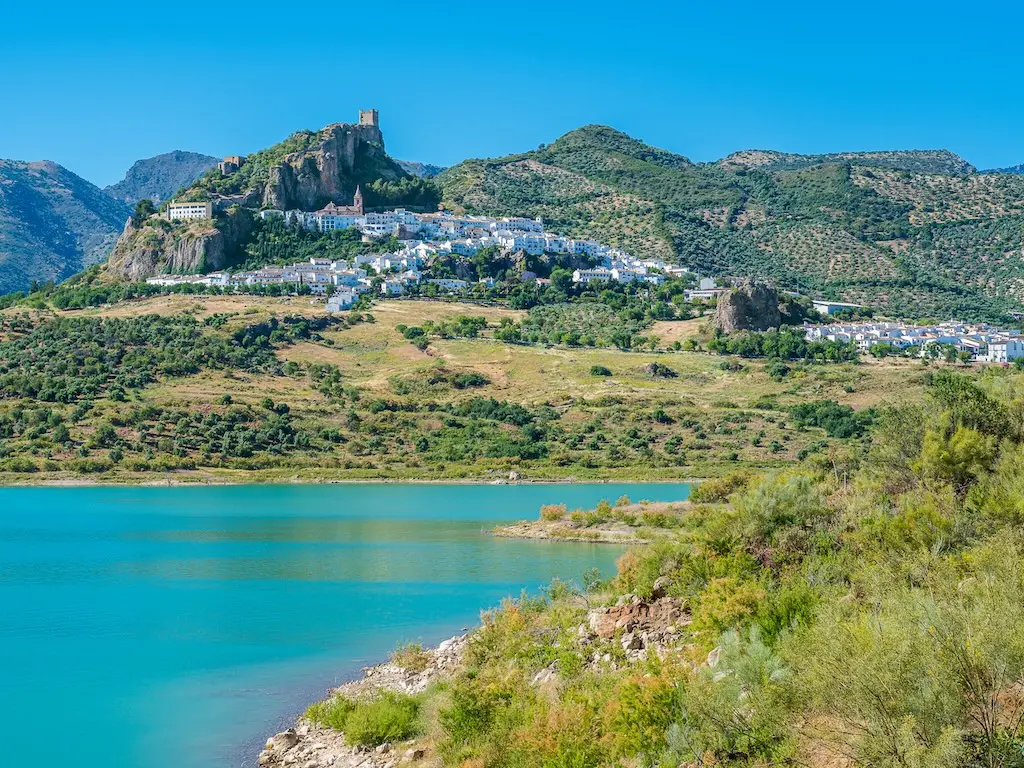

Zahara de la Sierra
Welcome to the sun-drenched heart of Andalucía, a region celebrated not only for its flamenco and fiestas but for its enchanting 'pueblos blancos'—the white villages that dazzle under the southern Spanish sky. These pristine havens, perched on rugged hillsides and nestled in lush valleys, are a testament to Andalucía's rich cultural tapestry and timeless allure.
In this article, we'll journey through my personal list of the ten most beautiful Andalucian white villages, each brimming with unique charm and history. While I’ve visited most of the pueblos blancos on this list, there are still a few that are on my wish list… and I’ll share why I love each of them.
From Ronda’s dramatic cliffs to Nerja’s captivating caves, and the quirky, blue-painted streets of Júzcar, prepare to be inspired.
Whether you're a history buff, a nature lover, or a culture vulture, these Andalucian villages promise to enchant and make you fall in love with the south of Spain. Get ready to immerse yourself in the beauty of Andalucía’s most picturesque villages.
Here are my picks for the 10 most beautiful white villages in Andalucia:
Read on to learn more about each of these stunning places to visit in Andalucia.
The white villages of Andalucía, or "pueblos blancos," are a collection of picturesque towns scattered across the southern Spanish regions of Cadiz and Malaga.
Characterised by their whitewashed buildings that gleam under the Andalucían sun, these villages are not only a feast for the eyes but also rich in history and culture. The white facades, often adorned with vibrant flowers, reflect a tradition aimed at repelling the fierce summer heat, rooted in a past that blends Moorish and Christian influences.
Visiting these white villages offers more than just the opportunity to see beautiful landscapes and architecture. It's a chance to dive into the heart of Andalucía's heritage, built through centuries of conquests, reconquests, and traditions that have passed down through generations. The region’s history is showcased through its well-preserved castles, churches, and fortresses, standing as proud reminders of the past.
But the appeal of the White Villages goes beyond their visual charm.
Life here moves at a slower pace, inviting you to unwind and soak in the local atmosphere. Each village hosts unique festivals and markets, offering a look into local customs and a taste of regional gastronomy that highlights Andalucía's agricultural bounty—from olives and almonds to sherry and cured meats.
For more active travellers, these villages are also gateways to outdoor adventures. Surrounded by natural parks and rugged mountains, they provide a playground for hiking, biking, and bird-watching enthusiasts.
In my opinion, any visit to Andalucia is greatly enhanced when you explore some of these villages. They’re a lovely counterpoint to the larger cities and provide a facet of Andalucia’s history. The scenic landscapes, combined with the warm hospitality of the local people, make the white villages a compelling destination for those looking to experience the essence of rural Spain.
Before we dive into my list, I’d just like to say that it was really tough to narrow down this to just 10. There are a handful of other pueblo blancos that I love that didn’t make it on this list. Doesn’t mean that they’re not worth visiting!
Also note that this list is not ranked. Because honestly, it’s impossible to say which one is my favourite. Each pueblo blanco really does have its own unique appeal and there’s something to love about each of them.
My aim with this article is to help you narrow down your choices if you want to add white villages to your Andalucia visit. I hope that you’ll find a pueblo or two (or three!) that strike your fancy and that you’ll add them to your Andalucia itinerary.And then, come back another time to see the rest of them!
Okay, let’s dive in.
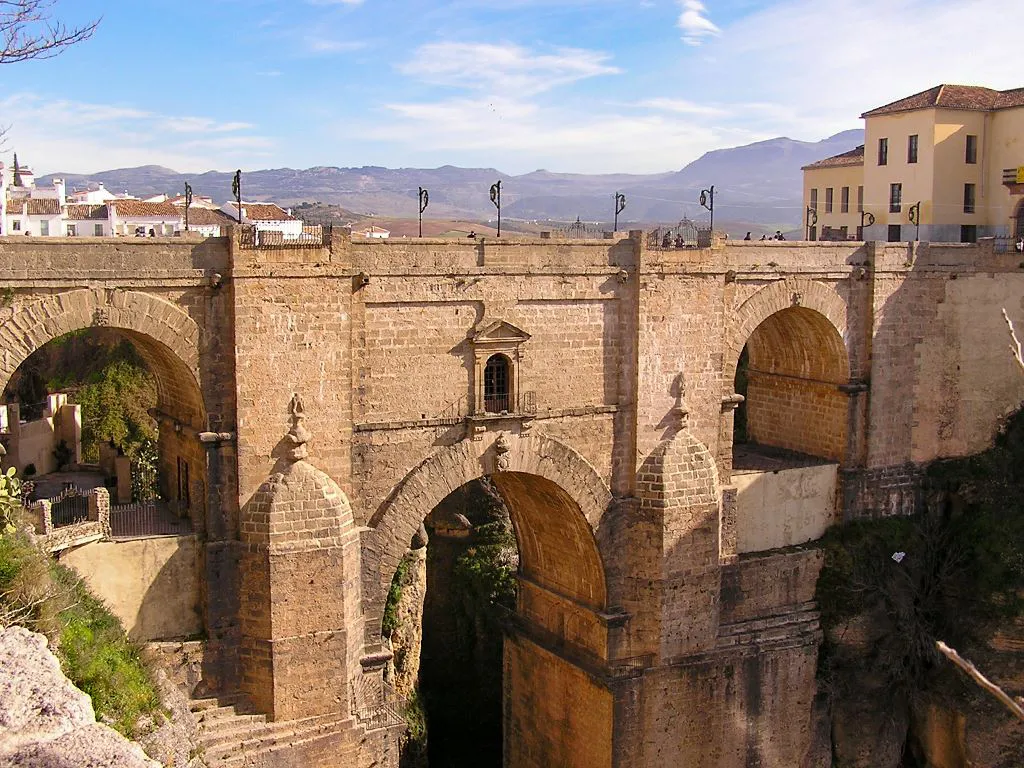

Tajo Bridge in Ronda
Must-Sees in Ronda: Stunning landscapes, Puente Nuevo, Plaza de Toros de Ronda
Perched dramatically above a deep gorge, Ronda offers a spectacle that is uniquely its own. This historic town in the heart of Andalucía is famed for its breathtaking views and rich past.
The Puente Nuevo, a stone bridge spanning the El Tajo gorge, serves as the city's stunning centrepiece. Built in the 18th century, it offers panoramic views of the surrounding mountains and the deep chasms below, making it a photographer’s paradise.
Ronda is steeped in history, with roots dating back to the Roman and Moorish eras, evident in its ancient walls and bridges. The town's bullring, one of the oldest and most revered in Spain, speaks to the enduring tradition of Spanish bullfighting.
For those drawn to natural beauty, the surrounding countryside provides ample opportunity for exploration. Vineyards dot the landscape, offering wine tastings that showcase the region's rich vinicultural offerings. Nearby hiking trails invite adventurers to discover the area's natural splendour up close.
Ronda is immensely popular with travellers but the hype shouldn’t put you off. When I visited, I was truly wowed by the dramatic setting and spectacular views of the Andalucian countryside. While many visit Ronda on a day trip, if you can, I recommend staying a night or two to enjoy the magic of the town at night.
Stroll through Ronda’s winding streets, explore its historic sites, and soak in the views that have inspired artists and writers for centuries. It’s easy to see why Ronda is well-loved as one of the most beautiful pueblos blancos.
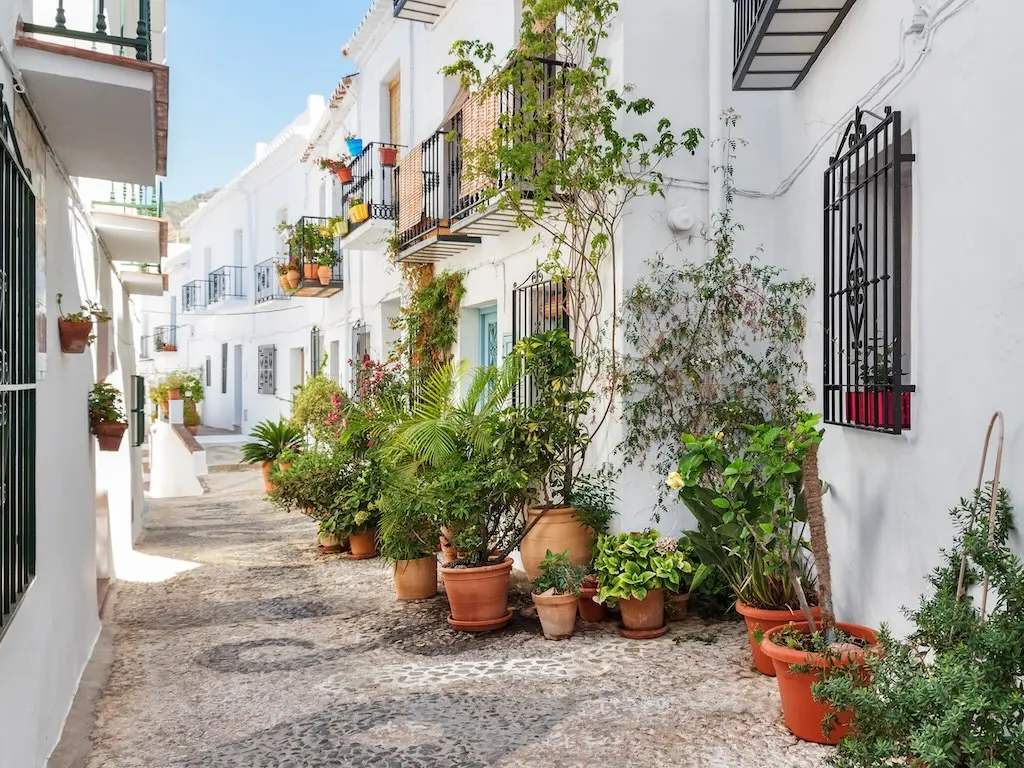

Charming street in Frigiliana
Must-Sees in Frigiliana: Moorish mazes, panoramic views, local ceramics
Nestled between the mountains and the Mediterranean, Frigiliana is often hailed as one of Andalucía's most picturesque villages. Its cobblestone streets and whitewashed houses are an enchanting mix of Moorish influence and Spanish charm, making it a delightful exploration for any visitor.
Visiting Frigiliana is on my wish list and it’s easy to see why it’s so appealing.
The heart of Frigiliana's allure lies in its beautifully preserved Old Quarter, with its narrow, winding streets that offer a glimpse into a bygone era. The Moorish past of the village is particularly tangible here, with every turn and alleyway revealing meticulously maintained architecture adorned with vibrant flowers.
The Church of San Antonio, standing proudly with its pristine façade, is a significant cultural landmark. Nearby, the panoramic views of the sea from the village's higher points are nothing short of spectacular, offering sweeping vistas of the deep blue Mediterranean contrasted against the stark white of the village homes.
Art and culture thrive in Frigiliana, with its numerous ceramic shops showcasing locally crafted pottery (a perfect memento to take home!). The village is also renowned for its annual festivals, which bring to life the traditions and gastronomy of the region, creating a festive atmosphere that captivates both locals and tourists alike.
Whether exploring during the lively festival season or enjoying a quieter sojourn, Frigiliana offers a timeless escape into the essence of Andalucía.
Read more about Frigiliana here
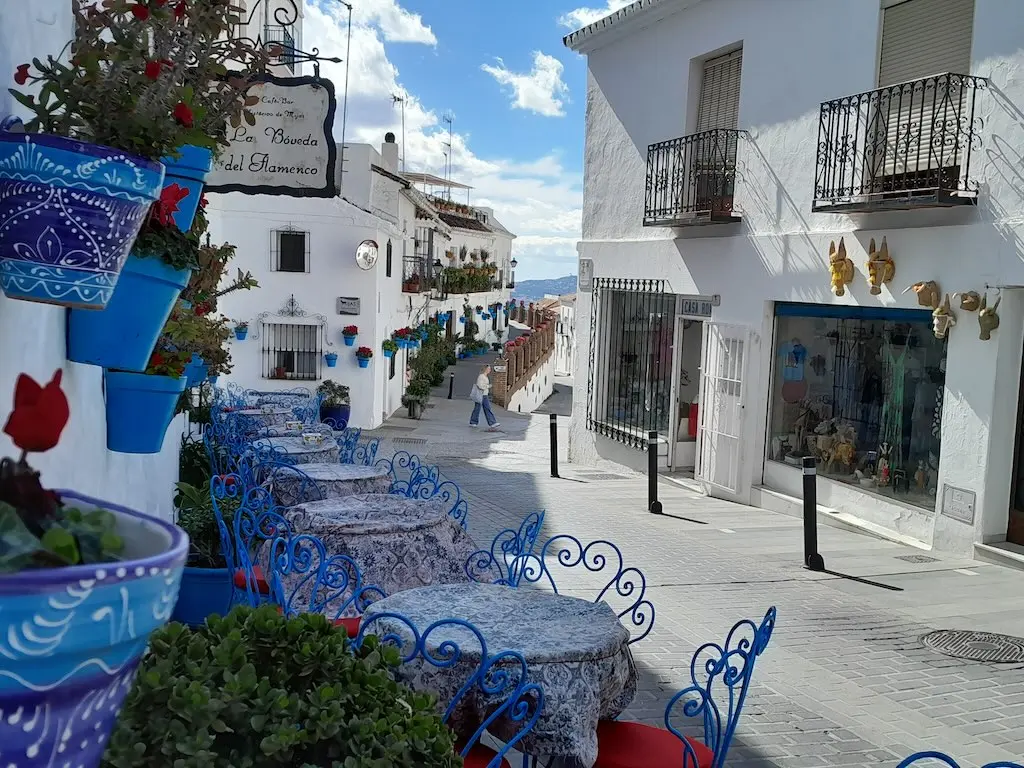

Mijas Pueblo
Must-Sees in Mijas: Traditional crafts, coastal views, charming atmosphere
Further down Costa del Sol from Nerja, perched in the mountains, you’ll find Mijas Pueblo, a gem of whitewashed buildings and vibrant bursts of bougainvillaea. This charming village blends traditional Andalucían culture with stunning coastal views, offering a serene escape from the bustling beaches below.
At the heart of Mijas is the Church of Immaculate Conception, originally built on the site of an old mosque. The church's tower, ingeniously adapted from the mosque’s minaret, highlights the historical layers that define the village.
When I visited Mijas, I simply loved strolling through the narrow cobblestone streets with their spotless whitewashed houses and splashes of floral colours. So beautiful!
As you explore the town, you’ll encounter local artisans crafting everything from leather goods to handmade pottery, perfect for unique souvenirs. The numerous galleries dotted around Mijas showcase works by local artists, reflecting the village's vibrant cultural scene.
And while donkey taxis are still a thing here, I’d personally opt for a tuk-tuk tour of Mijas instead.
For a sweet treat, stop by Mayan Monkey Mijas, reputed to be the smallest chocolate factory in the world. Here, you can indulge in chocolate-making workshops or simply savour the exquisite, locally produced chocolate.
Beyond the arts and crafts, the surrounding landscape invites nature lovers to explore. Head to Mirador del Paseo de la Muralla to admire panoramic views of the Mediterranean Sea. There are also hiking trails winding through the hills, for more active travellers. Exploring the mountains on a buggy is one of the most popular adventure activities here, if you’re up for it.
If you’re along Costa del Sol and want to experience more than just its beaches, Mijas Pueblo promises a picturesque and peaceful retreat.
Travel Tip: While visiting Mijas, spare some time to pop by the neighbouring Benalmadena Pueblo which is also charming and worth a visit.
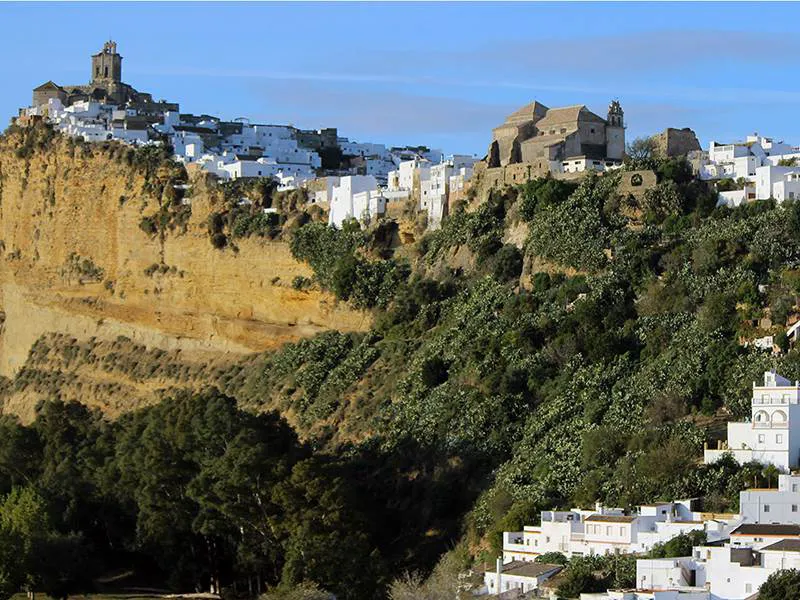

Arcos de la Frontera
Must-Sees in Arcos de la Frontera: Cliff-top views, Basilica de Santa María, Castillo de Arcos
Many white villages in Andalucia are set in stunning locations and, in my opinion, Arcos de la Frontera is definitely one of the most beautiful Andalucia white villages.
This pueblo blanco stands majestically atop a cliff, its white façades gleaming against the deep blue Andalucian sky. Known as the gateway to the white villages, this town offers a dramatic introduction to the region’s historical and architectural beauty.
The Basilica de Santa María, located in the heart of the old town, is a stunning example of Gothic and Baroque styles. Its intricate façade and richly decorated interior provide a fascinating glimpse into Spain’s ecclesiastical history.
Just a short walk away, the Castillo de Arcos, though largely in ruins, offers visitors a sense of the mediaeval might that once ruled this land.
For me, the absolute highlight of Acros are its breathtaking views over the surrounding countryside and the Guadalete River below.
The village is positioned on the edge of a limestone ridge and I was completely wow-ed by the views. This strategic location made it a key frontier during the Moorish and Christian re-conquests, and today, it provides an unparalleled vantage point for photographers and nature lovers alike.
For thrill-seekers, the area around Arcos is a popular spot for paragliding, offering a unique way to experience its stunning landscapes from the air. Horse-riding is another popular activity here.
Meanwhile, the winding streets of the old town are perfect for leisurely walks, revealing hidden courtyards, quaint shops, and local tapas bars that invite you to linger and soak in the atmosphere of this captivating town.
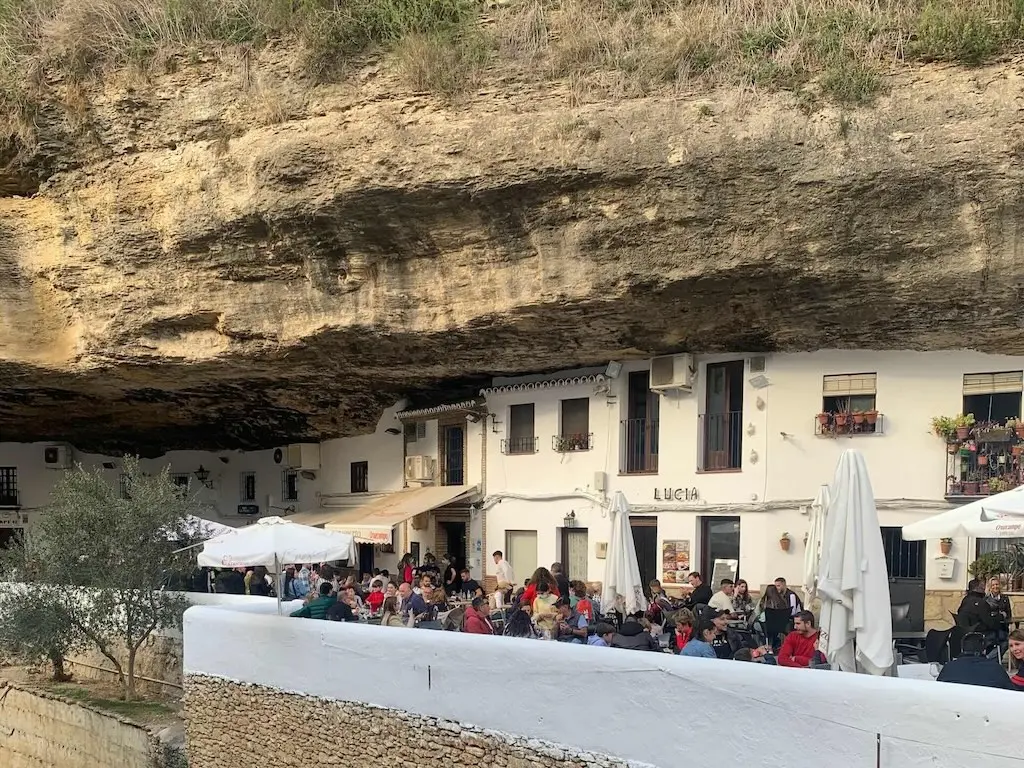

Calle Cuevas del Sol in Setenil de las Bodegas
Must-Sees in Setenil de las Bodegas: Rock-hewn homes, Cuevas del Sol, local tapas
Setenil de las Bodegas was one of the first white villages in Andalucia I visited and it has definitely left a lasting impression, thanks to its extraordinary harmony with nature.
Famous for its dwellings built into rock overhangs above the Rio Trejo, this white village offers an architectural experience unlike any other in Spain.
Cuevas del Sol, a street lined with white houses built directly into the cliff face, enjoys sunlight all day, making it a vibrant spot to explore local life. Here, the façades serve as the backdrop for bustling cafes and shops that offer everything from traditional crafts to local wines and olive oil.
Not to be missed are the tapas bars scattered throughout the village, where you can indulge in local specialties such as chorizo al infierno—spicy sausage flambeed right at your table. These culinary delights, paired with a glass of local wine, provide the perfect way to immerse yourself in the flavours of Setenil.
What I love most about Setenil de las Bodegas is the intertwining of natural landscape and urban setting which creates a unique and surreal environment. This beautiful white village not only showcases the adaptability of past generations of Andalucians but also offers a tranquil retreat from the typical tourist trail. That said, you may be surprised at how bustling Cueva del Sol can be, especially on the weekend!
One tip: don’t attempt to drive into the village as the narrow, winding streets are a nightmare to navigate (we almost got stuck in a narrow road!). Be sure to park in one of the parking lots just outside of the village and then walk to explore the village itself.


Zahara de la Sierra
Must-Sees in Zahara de la Sierra: Zahara Castle, Santa Maria de la Mesa Church, Zahara-El Gastor Reservoir
Zahara de la Sierra is a captivating white village that crowns a hilltop, offering spectacular views over the turquoise waters of the Zahara-El Gastor Reservoir and the rugged Sierra de Grazalema.
The stunning location and landscape are what put this pueblo blanco on my must-visit list!
This fortress village is a testament to its strategic historical importance, with its well-preserved mediaeval castle standing guard above the landscape.
Zahara Castle is definitely a highlight of the village and the rewarding trek to it leads you through cobbled streets lined with whitewashed homes. Once at the summit, the castle offers panoramic vistas that stretch across the valley, ideal for snapping hundreds of photos or simply soaking in the serene beauty of Andalucía. At the village's heart, the Church of Santa Maria de la Mesa dazzles with its exquisite 18th-century architecture, a striking contrast against the simple charm of the village houses. This beautiful church is not only a religious centre but also a cultural icon of Zahara de la Sierra. Beyond the village itself, you can enjoy leisurely activities at the Zahara-El Gastor Reservoir, where the options range from swimming and kayaking to simply picnicking by the water's edge. Whether you’re seeking a historical journey, architectural beauty, or a peaceful escape in nature, Zahara de la Sierra offers a diverse and enriching experience in Andalucia. Read more about Zahara de la Sierra here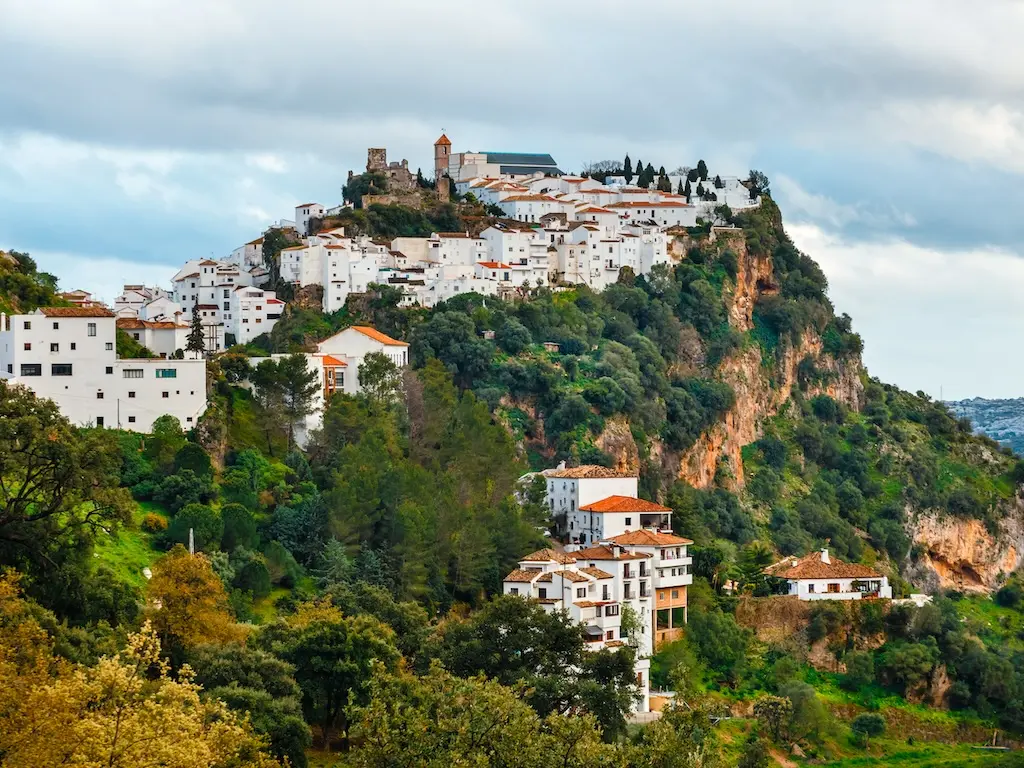

Casares
Must-Sees in Casares: Casares Castle, Church of San Sebastián, scenic nature walks
This lesser-known pueblo is a bit of a hidden gem, in my opinion.
Casares is a quintessential Andalucían white village that seems to tumble down the hillside, with its houses clinging precariously to the steep slopes. This picturesque village, just a stone's throw from the Mediterranean, combines rich history, stunning architecture, and breathtaking natural surroundings.
At the top of the village sits Casares Castle, which dates back to the Moorish period. The ruins of the castle offer sweeping views of the surrounding countryside and the sea, making it a perfect spot for sunset watchers and history enthusiasts alike.
Nearby, the Church of San Sebastián stands as a beautiful example of simple yet elegant 17th-century architecture, right in the heart of the village.
If you love the great outdoors like I do, Casares offers numerous nature walks and trails that wind through the surrounding hills and cork forests. Casares also boasts thermal baths that have been cherished since Roman times, providing a relaxing retreat for those looking to unwind.
Overall, Casares provides a captivating escape into the essence of rural Spain, making it a great white village to add to your Andalucian itinerary.
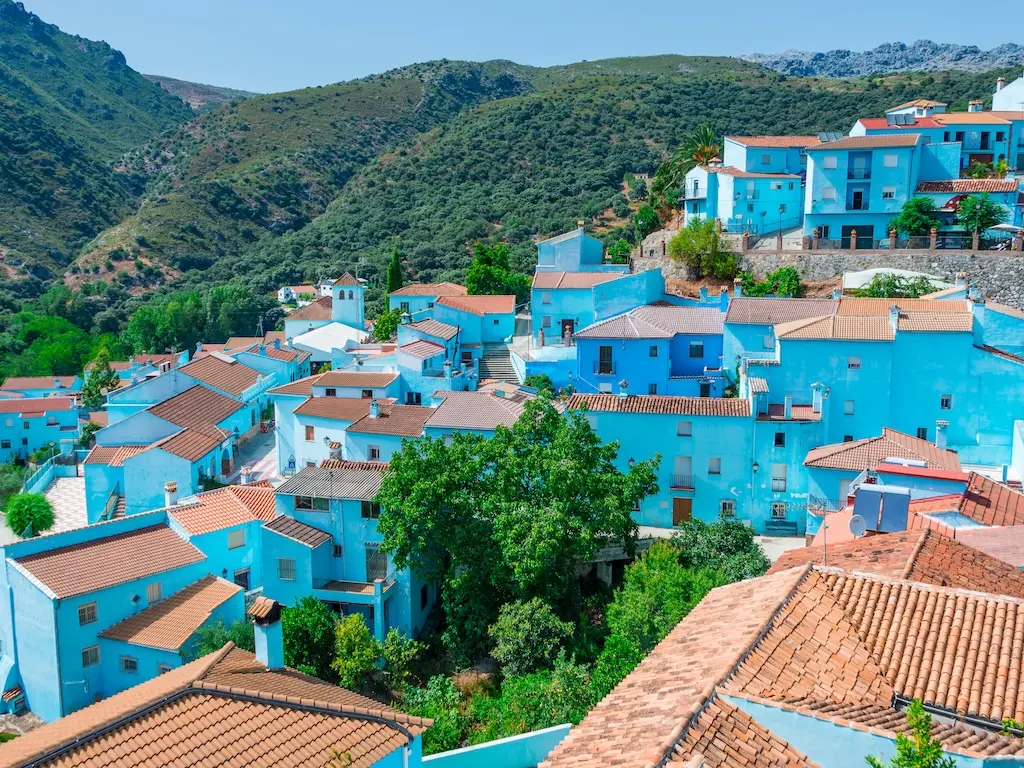
Must-Sees in Júzcar: Smurf-themed murals, mushroom hiking routes, forest adventures
If you wish to visit a white village that’s not quite like the others, then Júzcar should definitely be on your list (as it is on mine!).
This pueblo blanco was famously transformed from a traditional white village into a vibrant blue Smurf village in 2011 for a film promotion… and it has since embraced its unique identity with whimsical charm - it’s still blue!
Located in the lush valleys of Andalucia, not too far from Ronda, this once sleepy village now bursts with bright blue buildings and playful Smurf murals, creating a fairy-tale atmosphere that captivates visitors of all ages.
The village's transformation has made it a popular destination for families and animation enthusiasts, who can explore the streets adorned with Smurf characters and themed art. This colourful backdrop makes Júzcar an excellent spot for fun photo opportunities and a light-hearted exploration.
For nature lovers, Júzcar offers more than just quirky murals. The surrounding area is rich in dense forests and offers numerous hiking routes, particularly the well-known mushroom routes available in autumn. These trails allow hikers to discover the diverse fungal flora of the region, making it a perfect outing for ecological enthusiasts.
If you love adventure, there are more thrilling forest activities such as canyoning and river trekking, providing an exhilarating way to experience the natural beauty around Júzcar.
Júzcar’s unique Smurf-blue allure isn’t for everyone, and it’s okay. But there’s definitely something quirky and novel about it that makes it stand out from other villages in Andalucia which is why it’s on my Andalucia wish list.
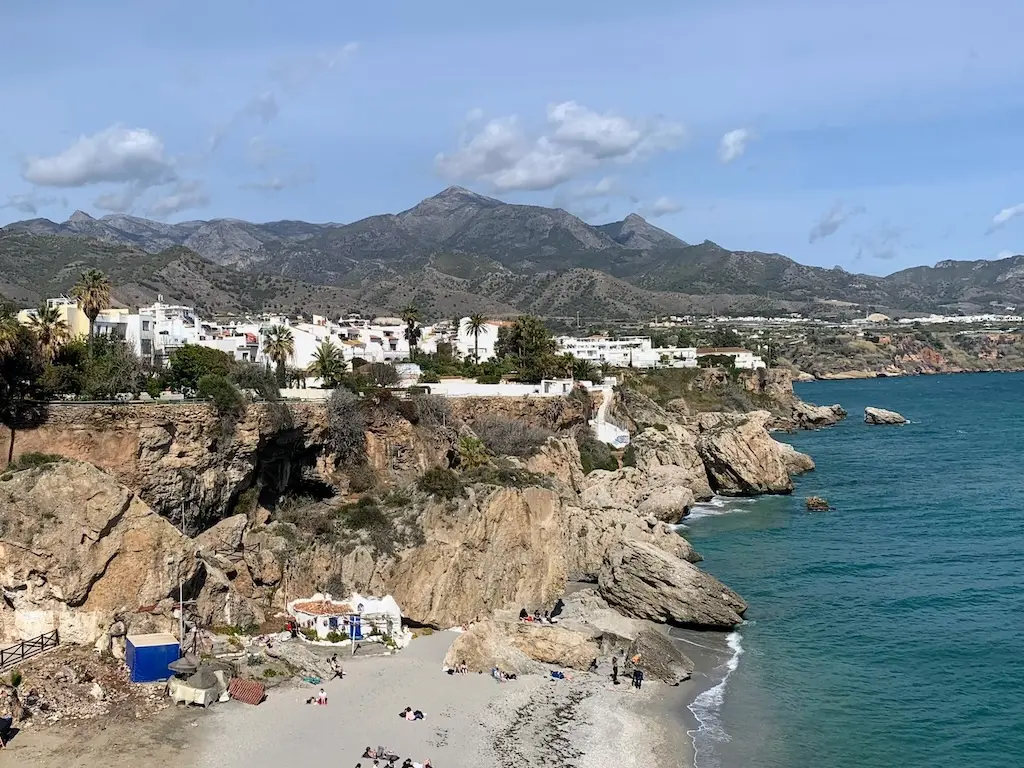
Must-Sees in Nerja: Nerja Caves, Balcón de Europa, Mediterranean beaches
Looking for a beautiful white village in Andalucia by the sea? My personal favourite is Nerja, a village perched on the rocky coastline of the Costa del Sol. This charming village is famous not only for its picturesque beaches but also for the spectacular Nerja Caves, one of Spain’s most popular and significant archaeological sites.
The Nerja Caves feature expansive caverns that host a variety of ancient stalactites and stalagmites, along with cave paintings that date back over 20,000 years. Guided tours provide a fascinating insight into the geological and historical significance of these caves, making it a must-visit for history buffs and nature enthusiasts.
Nerja is also known for its Balcón de Europa which offers breathtaking views of the Mediterranean Sea. Originally a fortress designed to keep out pirates, this prominent viewpoint now serves as the heart of Nerja, where visitors can soak in panoramic ocean vistas and enjoy a leisurely stroll along the adjacent promenade.
When I visited Nerja, I loved exploring the old town with its winding, cobblestoned streets, numerous shops, and lively bars and restaurants. And when you’re done with the town, the beaches are just a short walk away.
Nerja's beaches, from the bustling Playa Burriana to the secluded Calahonda, offer something for everyone whether you're interested in sunbathing, water sports , or just walking along the coastline. For adventure seekers, this kayak tour is an awesome way to see Nerja’s beautiful coast.
Combining stunning natural attractions with a lively yet traditional atmosphere, Nerja showcases the best of coastal Andalucia.
PS. Frigiliana and Nerja are very close and you can easily visit them together and tick off two places on your list at one go!
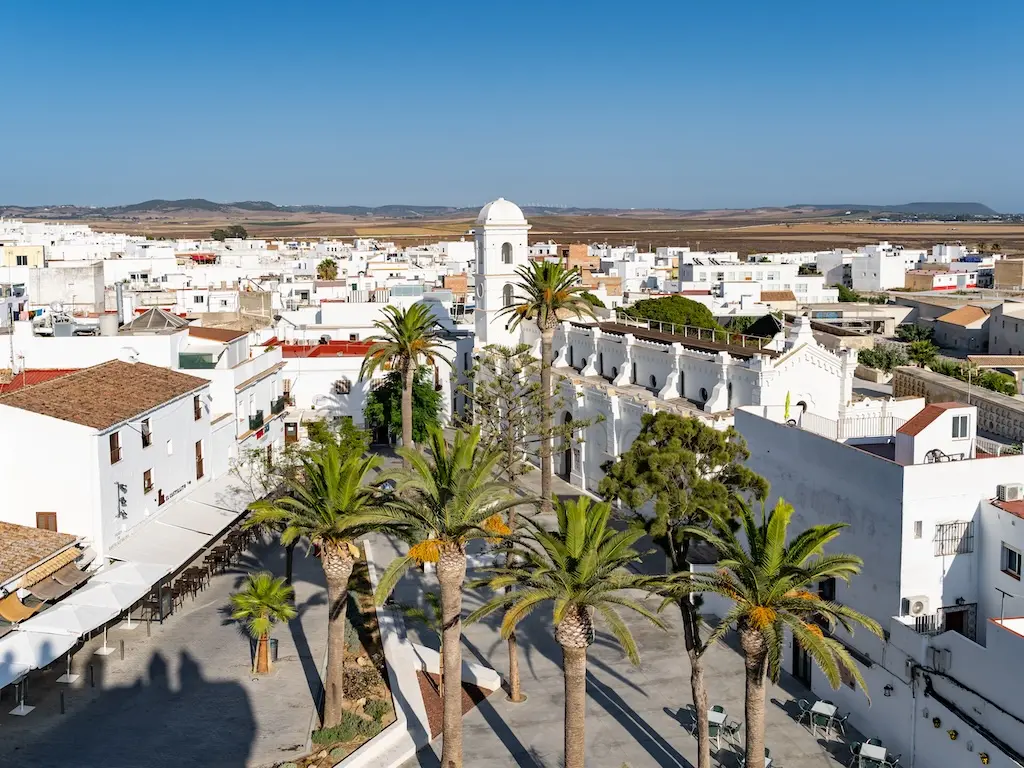
Must-Sees in Conil de la Frontera: Playa de los Bateles, Torre de Guzmán, vibrant nightlife
For a coastal white village that still’s under the radar, head to Conil de la Frontera in Costa de la Luz. Known for its expansive golden beaches and dynamic cultural scene, Conil is a favourite with locals and it’s ideal if you’re seeking the quintessential Spanish seaside experience.
One of the main attractions in Conil is Playa de los Bateles, a broad, sandy beach that is centrally located and ideal for swimming, sunbathing, and water sports. The beachfront is lined with lively bars and restaurants where visitors can sample local seafood dishes or enjoy a refreshing drink while watching the sunset.
In the heart of the village stands the Torre de Guzmán, a historical tower built in the 14th century. You can explore this well-preserved monument to learn about Conil's rich history as a defensive stronghold against pirate raids. The tower also offers panoramic views of the village and coastline.
Strolling through Conil’s Old Town, you will discover narrow cobbled streets, whitewashed houses, and hidden plazas that exemplify Andalucian charm. This area is perfect for leisurely walks, where you can soak in the local atmosphere and enjoy the traditional architecture that gives Conil its unique character.
And thanks to its restaurants and bars, it takes on a lively and vibrant atmosphere in the evenings.
This radiant coastal village in Andalucía offers a perfect blend of historical charm and beachside relaxation.
Read more about Conil de la Frontera here
The ideal times to explore the white villages of Andalucía are during the spring (April to June) and autumn (September to November) months. During these periods, the weather is pleasantly warm, and the landscapes are vibrant, avoiding the intense heat and crowded tourist spots of the summer.
Winter can also be charming, particularly in December when many villages host traditional festivals and markets, although temperatures can be cooler, especially at higher altitudes. I personally love travelling in Andalucia in winter as there are fewer crowds and there’s a more laid-back vibe.
Renting a car is highly recommended for visiting the white villages. Public transport can be infrequent, and having your own vehicle offers the flexibility to explore at your own pace and access more remote areas.
Be prepared for narrow, winding roads when driving in the mountains. Parking in the villages can be limited, so it’s often best to park on the outskirts and walk into the centres.
Travelling without a car? Some of the white villages are accessible by bus so you can still visit those easily. Check bus schedules in advance, as they can vary, especially on weekends and public holidays.If you’re without a car or have limited time in Andalucia, a guided tour of selected white villages can be a great way to see this part of the region.
Plus, a tour can provide a structured way to discover the history, architecture, and culture of these picturesque villages, all with the expertise of a local guide who is knowledgeable about regional history, traditions, and customs.
Here are some white villages day tours that you can check out:
In this journey through the most beautiful white villages of Andalucía, we've uncovered hidden gems where history, culture, and breathtaking landscapes converge.
From the dramatic cliffs of Ronda to the enchanting blue streets of Júzcar, each village offers its own unique allure, providing a glimpse into the region's rich heritage and vibrant local life.
And this list is just a quick taster of what you can discover. Check out more of the prettiest white villages in Andalucia here.
I hope this article has inspired you to explore this unique Andalucian heritage of white villages. On your next visit, immerse yourself in the tranquillity and beauty of Andalucía's pueblos blancos, and let each village tell you its own ancient story.
Buen viaje!
Want even more white villages to add to your Andalucia bucket list? Check out these articles:
Travelling to/around Spain and need some help? Here are our favourite travel resources.
We usually use Booking.com to look for hotels or apartment rentals. Lots of choice & you can unlock more discounts with their Genius loyalty programme!
To research transportation options around Spain, we like using Omio. It’s an easy way to compare different modes of transport and prices in one place. To search train routes, schedules, and prices, we recommend using Trainline.
Renting a car gives you the ultimate freedom to explore Andalucia at your own pace. Click here to compare car rental prices. (You’ll be surprised at how affordable it is in Spain!)
For last-minute holiday deals, check out Expedia UK.
Looking for things to do? Viator has a huge catalog of activities and tours across many cities in Spain. We also love Get Your Guide!
Guruwalk is our favourite platform to find the best free walking tours in a city.
For money transfers or spending overseas in foreign currency, Wise is our favorite borderless banking service (we love their debit card that's without fees!).
Travel insurance is a must to protect against emergencies and unexpected incidents. Get a quote from SafetyWing here.
For an easy way to stay connected on the road, get an eSim from Airalo. It's affordable and, best of all, you'll be connected the moment you arrive!